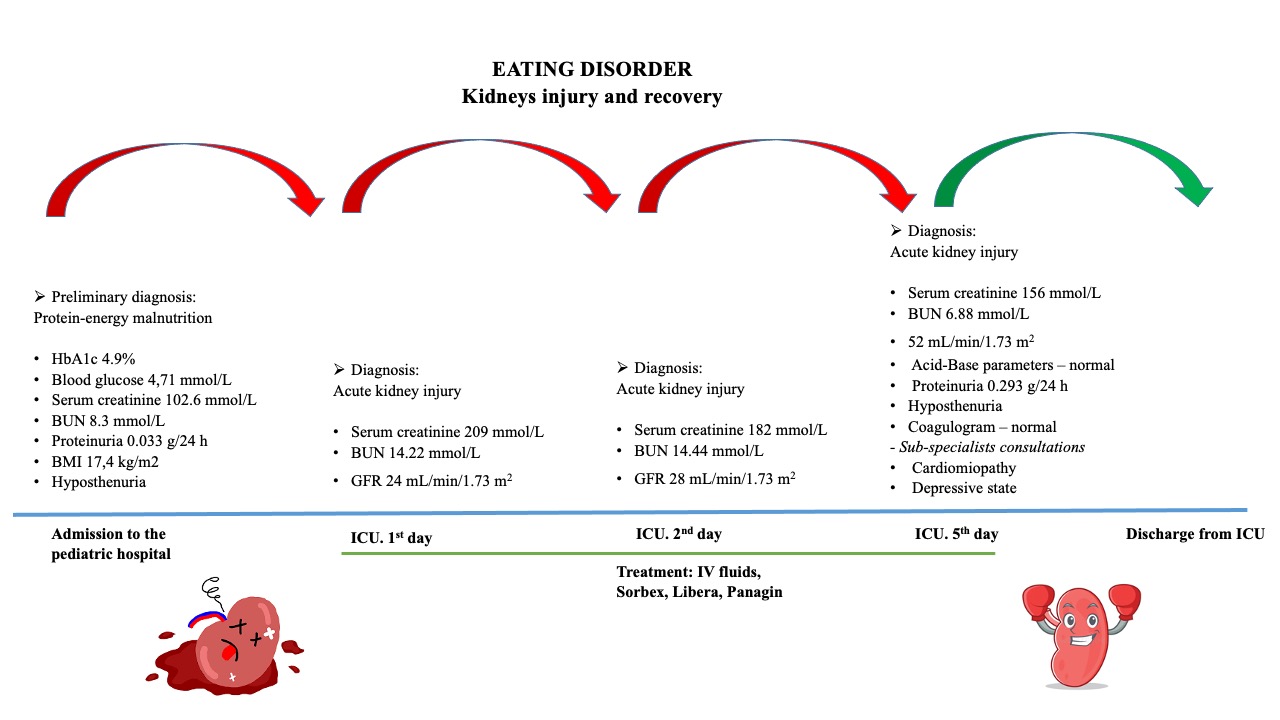Епізод порушення функції нирок у дитини з розладом харчової поведінки: клінічний випадок
DOI:
https://doi.org/10.15587/2519-4798.2024.300710Ключові слова:
розлад харчової поведінки, ураження нирок, діти, моніторингАнотація
Серед різних дисфункцій органів, на які серйозно впливають розлади харчової поведінки (РХП), є пошкодження нирок. Нирки є життєво важливими органами, відповідальними за низку основних функцій, включаючи баланс кислотно-лужного та мінерального метаболізмів організму, видалення та екскреція речовин, а також регулювання об’єму крові та тиску.
Розлади харчової повeдінки представляють поширений та актуальний в клінічному аспекті клас мультиорганних розладів, що виникає переважно у підлітковому віці. РХП часто мають серйозні клінічні прояви, які визначаються електролітним дисбалансом, ендокринними та психічними розладами, нирковою недостатністю, та іншими порушеннями. Поширеними розладами харчової поведінки, які обговорюються в літературі, та часто зустрічаються в клінічній практиці, є нервова анорексія та нервова булімія. Нервова анорекcія — це тип аномальної харчової поведінки, що включає в себе вживання дуже малої кількості їжі та може включати навмисне блювання або неправильне вживання проносних або діуретиків, вказаний розлад мав місце у обстеженої дитини та обговорений у даній публікації.
Нирки виконують ряд життєво важливих функцій, для підтримки гомеостазу в нашому організмі. Однією з основних функцій нирок є фільтрація крові, виведення продуктів метаболізму. Це дозволяє підтримувати оптимальний рівень рідини, електролітів та виводити токсини. Рестрикція вживання рідини, зловживання сечогінними може спричинити зниження припливу крові до нирок і подальшу ниркову недостатність. Результатом останнього є розвиток серйозних порушень вітальних функцій. Низьке споживання білка у раціоні у людей, які дотримуються обмеженої дієти (рестриктивна анорексія), призводить до зниження швидкості клубочкової фільтрації (ШКФ) і ниркового плазмотоку. Лікування гострого ураження нирок на фоні дефіциту об’єму внаслідок втрати рідини передбачає її припинення та гідратацію перорально або за допомогою внутрішньовенних інфузій фізіологічного розчину залежно від тяжкості дефіциту об’єму та ураження нирок, що спостерігалось та описано у даному клінічному випадку.
Мета. Проаналізувати особливості ураження нирок у дитини з розладом харчової поведінки.
Матеріали та методи. Проведено детальний аналіз історії хвороби дитини з діагнозом розлад харчової поведінки, ускладнений гострим епізодом порушення функції нирок. У роботі проаналізовано та наведено основні анамнестичні, клінічні, лабораторні та інструментальні дані. Графічна презентація виконана за допомогою PowerPoint.
Результати. Приведено аналіз клінічного випадку 14-річної пацієнтки з діагнозом та гостре пошкодження нирок (ГПН), що призвело до менеджменту дитини у відділенні інтенсивної терапії.
Висновки. ГПН може бути наслідком ряду станів, поширених серед хворих на анорексію, включаючи зневоднення, високий артеріальний тиск, токсини, неправильне харчування та, можливо, електролітні дізьаланси. Креатинін сироватки, азот сечовини крові, швидкість клубочкової фільтрації (ШКФ) і електроліти є одними з маркерів функції нирок, які необхідно контролювати на ранніх стадіях ГПН, пов’язаного з анорексією. Правильно підібрана медична допомога, що включає нормалізацію артеріального тиску та достатню гідратацію, призводить до стабілізації пацієнта. Важливе значення має подальше спостереження за функцією нирок у таких пацієнтів.
Посилання
- Puckett, L. (2023). Renal and electrolyte complications in eating disorders: a comprehensive review. Journal of Eating Disorders, 11 (1). https://doi.org/10.1186/s40337-023-00751-w
- Gurevich, E., Steiling, S., Landau, D. (2021). Incidence of Impaired Kidney Function Among Adolescent Patients Hospitalized With Anorexia Nervosa. JAMA Network Open, 4 (11), e2134908. https://doi.org/10.1001/jamanetworkopen.2021.34908
- Stheneur, C., Bergeron, S., Lapeyraque, A.-L. (2014). Renal complications in anorexia nervosa. Eating and Weight Disorders - Studies on Anorexia, Bulimia and Obesity, 19 (4), 455–460. https://doi.org/10.1007/s40519-014-0138-z
- Coca, S. G., Singanamala, S., Parikh, C. R. (2012). Chronic kidney disease after acute kidney injury: a systematic review and meta-analysis. Kidney International, 81 (5), 442–448. https://doi.org/10.1038/ki.2011.379
- Hundemer, G. L., Clarke, A., Akbari, A., Bugeja, A., Massicotte-Azarniouch, D., Knoll, G. et al. (2022). Analysis of Electrolyte Abnormalities in Adolescents and Adults and Subsequent Diagnosis of an Eating Disorder. JAMA Network Open, 5 (11), e2240809. https://doi.org/10.1001/jamanetworkopen.2022.40809
- Marumoto, H., Sasaki, T., Tsuboi, N., Ito, T., Ishikawa, M., Ogura, M. et al. (2020). Kidney Disease Associated With Anorexia Nervosa: A Case Series With Kidney Biopsies. Kidney Medicine, 2 (4), 418–424. https://doi.org/10.1016/j.xkme.2020.03.007
- El Ghoch, M., Calugi, S., Dalle Grave, R. (2016). Management of Severe Rhabdomyolysis and Exercise-Associated Hyponatremia in a Female with Anorexia Nervosa and Excessive Compulsive Exercising. Case Reports in Medicine, 2016, 1–5. https://doi.org/10.1155/2016/8194160
- Nitsch, A., Dlugosz, H., Gibson, D., Mehler, P. S. (2021). Medical complications of bulimia nervosa. Cleveland Clinic Journal of Medicine, 88 (6), 333–343. https://doi.org/10.3949/ccjm.88a.20168
- Kermond, R., Mallett, A., McCarthy, H. (2022). A clinical approach to tubulopathies in children and young adults. Pediatric Nephrology, 38 (3), 651–662. https://doi.org/10.1007/s00467-022-05606-1
- Dalle Grave, R. (2008). Excessive and compulsive exercise in eating disorders: prevalence, associated features, and management. Directions in Psychiatry, 28.21, 273–282.

##submission.downloads##
Опубліковано
Як цитувати
Номер
Розділ
Ліцензія
Авторське право (c) 2024 Ievgeniia Burlaka, Inga Mityuryayeva

Ця робота ліцензується відповідно до Creative Commons Attribution 4.0 International License.
Наше видання використовує положення про авторські права Creative Commons CC BY для журналів відкритого доступу.
Автори, які публікуються у цьому журналі, погоджуються з наступними умовами:
1. Автори залишають за собою право на авторство своєї роботи та передають журналу право першої публікації цієї роботи на умовах ліцензії Creative Commons CC BY, котра дозволяє іншим особам вільно розповсюджувати опубліковану роботу з обов'язковим посиланням на авторів оригінальної роботи та першу публікацію роботи у цьому журналі.
2. Автори мають право укладати самостійні додаткові угоди щодо неексклюзивного розповсюдження роботи у тому вигляді, в якому вона була опублікована цим журналом (наприклад, розміщувати роботу в електронному сховищі установи або публікувати у складі монографії), за умови збереження посилання на першу публікацію роботи у цьому журналі.









